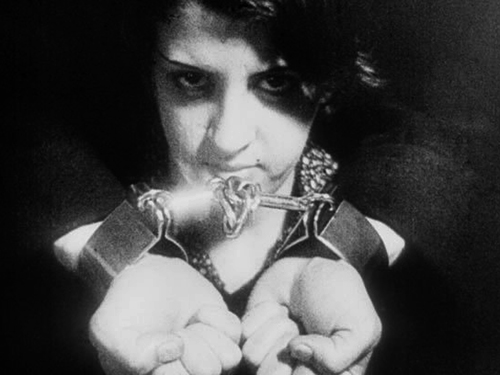
An astonishing creation, Limite is the only feature by the Brazilian director and author Mário Peixoto, made when he was just twenty-two years old. Inspired by a haunting André Kertész photograph on the cover of a French magazine, this avant-garde silent masterpiece centers on a man and two women lost at sea, their pasts unfolding through flashbacks propelled by the music of Erik Satie, Claude Debussy, Igor Stravinsky, and others. An early work of independent Latin American filmmaking, Limite was famously difficult to see for most of the twentieth century. It is a pioneering achievement that continues to captivate with its timeless visual poetry. (The Criterion Collection)
EN
“Peixoto’s synthesis of the many different schools of silent cinema has been rightfully emphasized throughout the years. His unique style collides a sophisticated understanding of Griffith’s decoupage with Soviet montage, existential motifs sipped from the waters of French impressionism, and expressive camera work inspired by German cinema. The cinematography is taken to unforeseen extremes by the extraordinarily inventive work of director of photography Edgar Brasil – himself German-born – who built camera cranes and dollies to fulfill and expand the director’s vision, and stretched the film’s latitude to capture the tropical sun in its ravishing fury. Yet what could seem like a superficial stylistic collage is only the loose thread leading to the deep pattern of contrasts and heterogeneity that makes this such a singular film.
Limite is both poetry and prose; a metaphor about the inexorability of the human condition as much as it is an experience of tactile memories, salty wind and sunburnt skin. The film reveals depth by adhering to the surface, finding common ground for Robert Flaherty’s direct approach (the near absence of makeup, the fraying costumes, the merciless glow of the sun) and Man Ray’s exploration of film as a flat canvas (of fabric, of sand, of newspaper headlines). The shots alternate between perspectives, using the camera as a polyphonic narrator: it can ‘see’ as a character, as the wind, as the wheel of a train, creating a rhythmic experience that aspires to transcend physicality yet is always pulled back to the physical world, much like the stranded boat.”
Fábio Andrade1
“Imagistically the film tends towards abstraction, often recontexting objects through excentric framing and disorientingly outsized close-ups. The plastic beauty and sensuous tactile quality of the images contrasts strikingly with the structural pessimism of the film. [...] The editing places identical shots in diverse syntagmatic contexts, structurally varying their meaning. Visual analogies link train wheels and sewing machines, telegraph wires and trees, a fish and a boat’s prow. And the climactic tour-de-force storm sequence consists of roughly seven shots of crashing surfs and eddying swirls of water, edited into a frenzy so as to suggest a tempest on the high seas.”
Robert Stam2
- 1Fábio Andrade, “Limite: Memory in the Present Tense,” The Criterion Collection, 31 May 2017.
- 2Robert Stam, “On The Margins: Brazilian Avant-Garde Cinema,” in Randal Johnson & Robert Stam, Brazilian Cinema (London and Toronto: Associated University Presses, 1982), 308-309.
FR
« C’est également par rapport au mythe [qui existait autour du film] que Glauber Rocha réagit dans le chapitre “Le mythe Limite” dans son livre Revisão critica do cinema brasileiro (editora Civilização Brasileira, Rio de Janeiro, 1963). Après avoir avoué qu’il a tout lu et entendu au sujet du film, il dit : « je n’ai jamais pu voir Limite et je doute que cela sera possible un jour ». Et Glauber affirme que « ces films d’art pour l’art, pur cinéma, des films beaux seulement par leur beauté, dans la subjectivité de sentiments bourgeois », ne présentent aucun intérêt ; et que, transformé en « monstre sacré, mythe impénétrable, Limite est un événement tragique dans l’histoire du cinéma brésilien : parmi les gens de cinéma de la génération de 1930 le fanatisme pour Limite a eu des conséquences stérilisantes, même pour Mário Peixoto, qui n’a plus réussi à rien tourner par la suite ». Il parle du besoin urgent de « récupérer cette espèce de Mona Lisa de notre cinéma » [...] »
José Carlos Avellar1
- 1 José Carlos Avellar, « Le lieu sans limites, » Cinémas d’Amérique latine, 16, 2008, 32-64.


